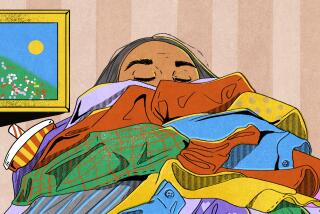Motivation Is 1st Step to Organization
- Share via
In a recent ranking of the top 10 consumer intentions, getting better organized came third--behind having more fun and losing weight.
The statistic is provided by Rubbermaid Inc., a producer of storage organizers in Wooster, Ohio. The company also found a 16% increase between 1995 and 1997 in the number of people who said they wanted to rearrange their possessions.
These figures don’t surprise Michelle Passoff, author of a new book, “Lighten Up! Free Yourself From Clutter” (Harper Perennial, $13 softcover). “Clutter at home is a condition of our times,” she says, one that makes many people feel out of control.
“People of all ages, locales and economic situations need help with their clutter,” says Passoff, who counsels clients and conducts decluttering workshops around the country.
Besides organizing surveys and focus groups to get information on storage needs, Rubbermaid looks into people’s homes to get a clearer perspective on clutter.
In a case of out-of-sight, out-of-mind, the biggest messes seem to be in the closet.
“People tend to pile up the boxes, making it hard to get at their stuff,” said Bill Hauser, Rubbermaid’s manager of business development and research.
But maybe that’s not such a problem. What’s in those boxes often are items of nostalgia such as the kids’ early art work and toys, and outgrown or outdated clothing.
“There is less of a throwaway mentality today, with many people saving items to reuse them or with the idea that they may have value as collectibles,” Hauser added.
Passoff occasionally runs into string savers with a pathological inability to discard anything. But, she says, most of her clients simply have too much stuff and don’t know much about how to organize.
The dimensions of the problem are familiar. What to do about it?
Once you’re motivated, there are two stages in decluttering. The first is to go through the items that have accumulated over a long period and decide what to discard.
“Think of this as detoxification,” Passoff said.
Passoff recommends that people wait until the second stage to buy storage products such as shelves, files, boxes and other organizers. That’s when you reorganize what you want to keep.
“This is the fun part and the place where interior design comes in,” according to Passoff--”where you get to decide if you prefer black or white cabinets, wicker, wood or plastic containers, and where you get to choose matching hangers.”
Incidentally, anecdotal evidence suggests both sexes are equally disorganized.
“Women are more likely to seek help,” Passoff said. But she sees no difference between female and male clients in the desire to be more organized.
More to Read
Inside the business of entertainment
The Wide Shot brings you news, analysis and insights on everything from streaming wars to production — and what it all means for the future.
You may occasionally receive promotional content from the Los Angeles Times.









